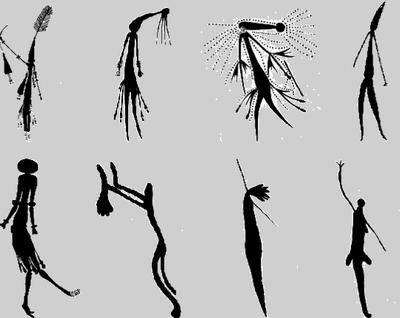
Nor can I remember exactly where I found it, obviously in some book or other because I still have a copy of the xerox I took. It's a graphic translation, by an unknown hand, of one of the so-called Bradshaw Figures, rock art of the Kimberley region in north west Australia.
The Bradshaws - named after a Joseph Bradshaw who first 'discovered' them in 1891 - are an enigma. They haven't been reliably dated and no-one has yet advanced a convincing explanation of who made them. They are very different stylistically from the wondjina tradition of painting that still survives up there.
To my eye, and this has of course been noted by others, they have affinities with figurative rock art tradtions in other parts of the world, particularly Africa. There have been more or less scholarly attempts to compare the Bradshaws with similar figures from both southern and northern (Algeria) African traditions.
This figure of a dancer, so graceful, insoucient, and free, was in many ways the original inspiration for Luca Antara, the book, she makes a brief appearance in it and I'm just now in discussions with the publisher which may lead to the inclusion of her image in the book as well. This would please me very much if it happens.
Some recent dates for the Bradshaws suggest they are about 17,000 years old, that is, they were made around the time of the last glacial maximum. It is a matter of fact that a great deal of land off the western and northern coasts of Australia was submerged as the ice melted and the ocean came flooding back. Large parts of what is now Indonesia also disappeared.
I've never been able to dismiss the possibility that the Bradshaws are the art of a culture and tradition that was more or less wiped out by the rising seas sometime in the last 10,000 years or so. I'm aware that there are various certifiable crackpots who have elaborated vast, fanciful dream towers about this thematic and I deny that I'm one of them.
But somebody made the Bradshaws and they show a sophistication which, while it certainly can't be used to support the idea of some Atlantis type lost civilisation, may still represent a flowering of a culture whose other artefacts and achievments now lie under the Timor Sea. This is likely to have been an indigenous Australian - ie Aboriginal - culture with strong ties to those of nearby Sundaland.
Some more images:


3 comments:
That guy in a funny hat who does these fantastic, survival-in-the-outback documentaries that only Prime (or our local Dunedin channel) ever show, once did a spot on these cave drawings on an episode he did on the Kimberlys. Amazing stuff. There he was in this cave, his voice echoing from the walls ... and these drawings - just there! It was a moment - and that's just from a sitting position on our couch - imagine actually being there inside that cave. Have you been to see?
These dancing figures a great. Sort of remind me of the Rongorongo figures of Easter island.
no, alas, chiefbiscuit, I have not - nearly, once, years ago ... but then, Oz is inscribed all over & I have spent time with the rock art of the Sydney region, much of which has never been classified, is still just - there.
hi John - yeah, the talking boards! it's amazing to think there are literally tens of thousands of these figures up there.
Post a Comment